Anatomy and physiology of the eye. Human Eye Anatomy and Physiology: A Comprehensive Guide to Vision
How does the human eye function. What are the primary components of the eye. How do different parts of the eye work together to create vision. What role do optic nerves play in visual processing. How do rod and cone cells contribute to our ability to see.
The Remarkable Structure of the Human Eye
The human eye is an extraordinary organ that allows us to perceive the world around us through vision. As one of the five major sense organs in the human body, the eye plays a crucial role in our daily lives, enabling us to navigate our environment, recognize faces, and appreciate the beauty of our surroundings. Understanding the intricate anatomy and physiology of the eye is essential for comprehending how this remarkable organ functions.
The eye is roughly spherical in shape, though it appears convex due to the covering of the eyelids. Its complex structure consists of various components that work together seamlessly to capture light and transform it into visual information that our brain can interpret.
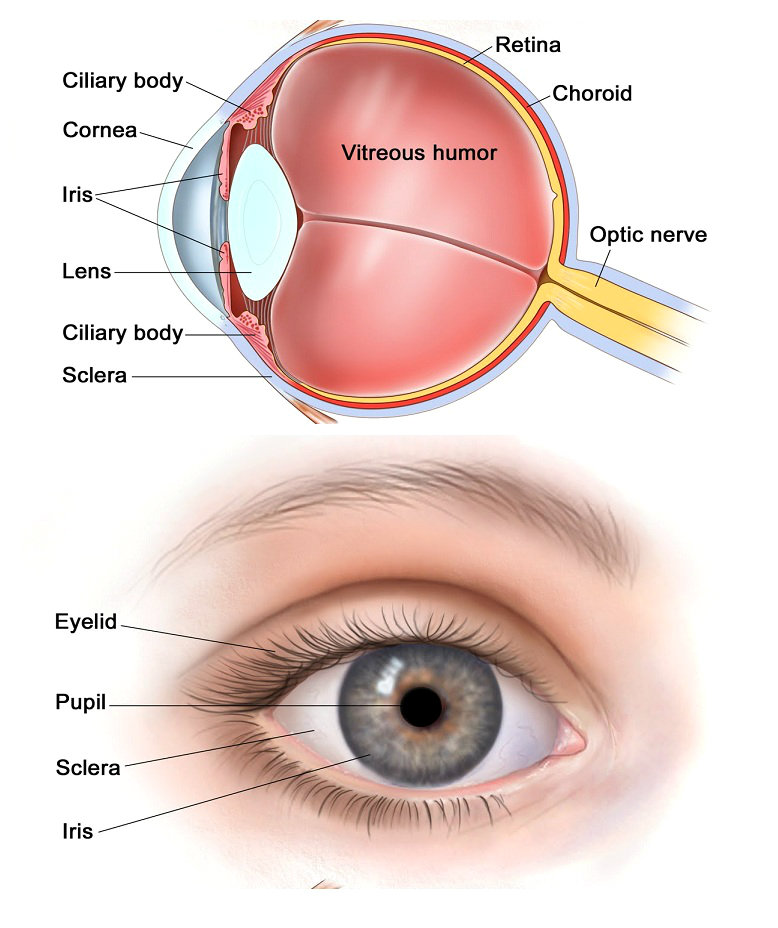
Primary Components of the Eye
The human eye is composed of several key structures, each with a specific function in the visual process:
- Cornea
- Sclera
- Aqueous Humor
- Iris
- Pupil
- Lens
- Ciliary Muscles
- Vitreous Humor
- Retina
These components work in harmony to capture light, focus it, and convert it into electrical signals that can be interpreted by the brain.
The Cornea: The Eye’s Transparent Shield
The cornea is the clear, dome-shaped surface at the front of the eye. It serves as a protective barrier and plays a crucial role in focusing light as it enters the eye. What makes the cornea unique?
- Transparency: The cornea is completely transparent, allowing light to pass through unobstructed.
- Avascular structure: It contains no blood vessels, which helps maintain its clarity.
- High sensitivity: The cornea is one of the most sensitive tissues in the body, with a dense network of nerve endings.
How does the cornea contribute to vision? The cornea acts as the eye’s outermost lens, refracting light to help the eye focus. In fact, the cornea is responsible for about 65-75% of the eye’s total focusing power.
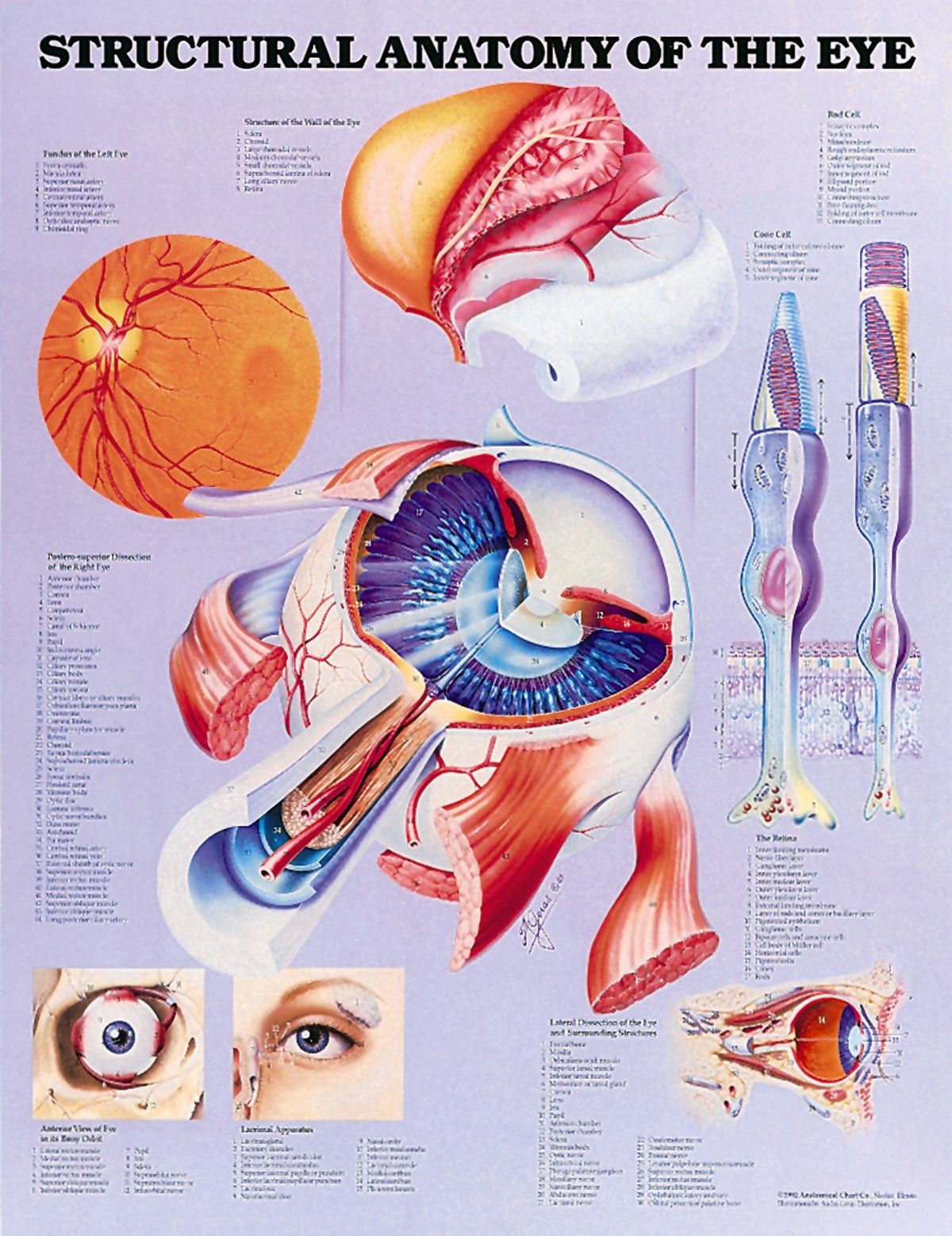
The Sclera: The White of the Eye
The sclera is the white, opaque outer layer of the eye that covers most of the eyeball. What are the key features of the sclera?
- Protective function: The sclera provides structure and protection for the inner components of the eye.
- Attachment point: It serves as an attachment site for the extraocular muscles that control eye movement.
- Composition: The sclera is composed of tough, fibrous tissue that gives the eye its shape and helps maintain intraocular pressure.
Why is the sclera white? The white color of the sclera is due to its high collagen content and relative avascularity. This whiteness provides contrast to the colored iris, allowing for better communication of eye direction and emotional cues in social interactions.
Aqueous and Vitreous Humor: The Eye’s Vital Fluids
The eye contains two distinct fluid-filled chambers: the anterior chamber filled with aqueous humor, and the larger posterior chamber filled with vitreous humor. How do these fluids contribute to eye function?
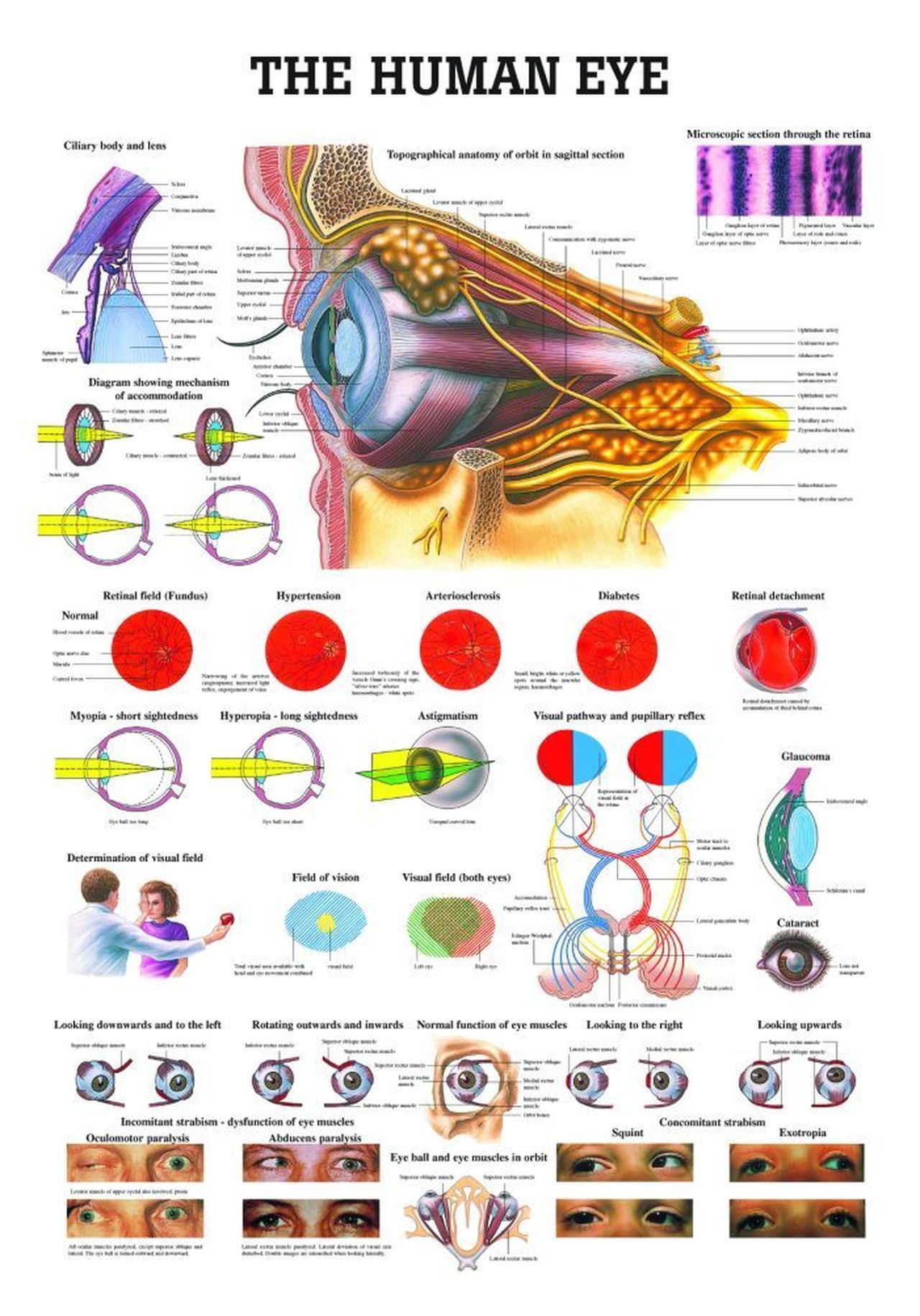
Aqueous Humor
The aqueous humor is a clear, watery fluid that fills the space between the cornea and the lens. What are its primary functions?
- Nourishment: It provides oxygen and nutrients to the avascular structures of the eye, such as the cornea and lens.
- Pressure regulation: The production and drainage of aqueous humor help maintain proper intraocular pressure.
- Refractive properties: Its composition contributes to the eye’s overall refractive power.
The aqueous humor is constantly produced and drained, maintaining a delicate balance within the eye. Disruptions in this balance can lead to conditions such as glaucoma.
Vitreous Humor
The vitreous humor is a clear, gel-like substance that fills the space behind the lens and in front of the retina. What makes the vitreous humor unique?
- Consistency: Despite its name, the vitreous humor is not liquid but a transparent, collagen-rich gel.
- Stability: It helps maintain the shape of the eye and keeps the retina in place.
- Optical function: The vitreous contributes to the eye’s refractive properties and helps in the transmission of light to the retina.
Unlike the aqueous humor, the vitreous humor is not continuously replenished. Changes in its composition or structure can lead to visual disturbances, such as floaters or retinal detachment.
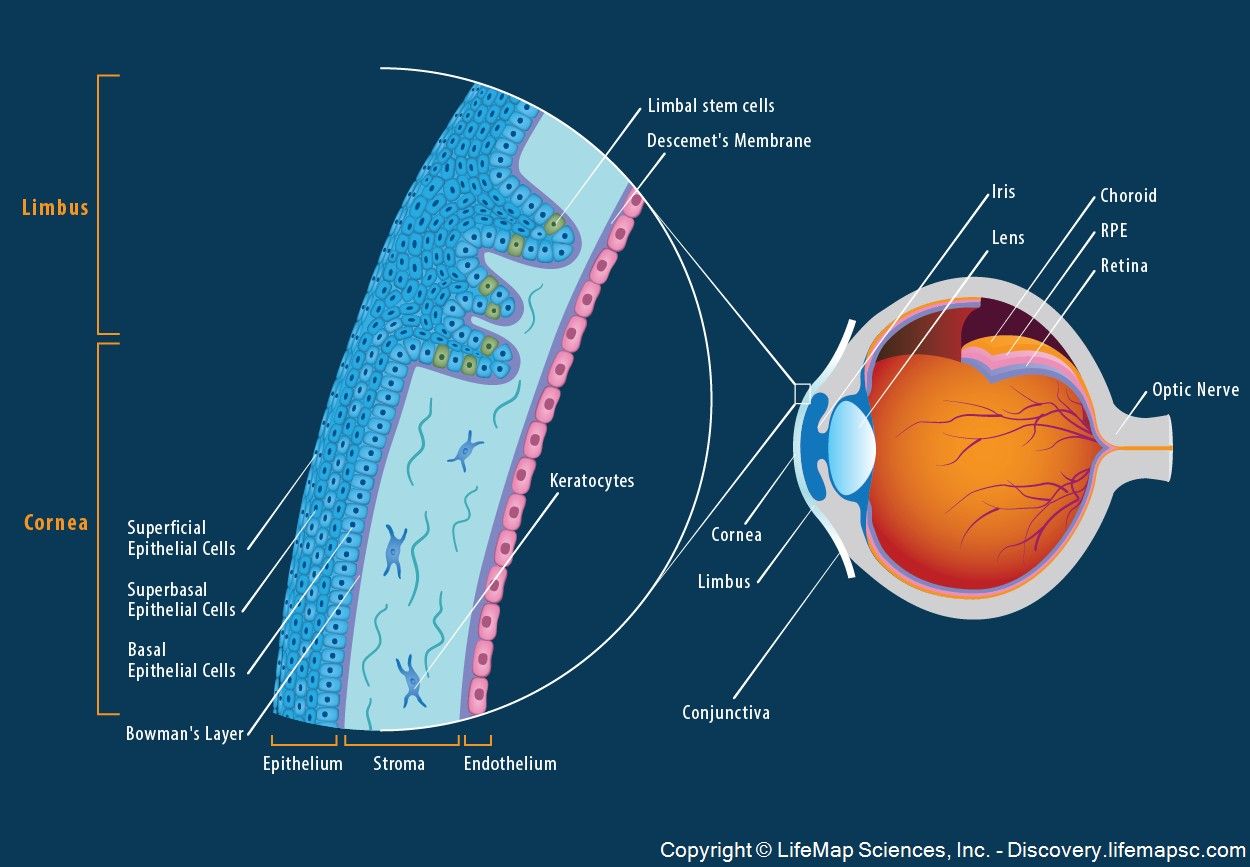
The Iris and Pupil: Regulating Light Entry
The iris and pupil work together to control the amount of light entering the eye. How do these structures function?
The Iris: Nature’s Light Diaphragm
The iris is the colored portion of the eye, visible through the transparent cornea. What are its key characteristics?
- Pigmentation: The iris contains pigments that determine eye color, which can range from light blue to dark brown.
- Muscular structure: It consists of two sets of muscles – the sphincter pupillae and the dilator pupillae.
- Light regulation: By contracting or relaxing, these muscles adjust the size of the pupil, controlling light entry.
How does iris color develop? Eye color is determined by genetics and the amount of melanin pigment in the iris. The distribution and type of melanin create the wide variety of eye colors we see in humans.
The Pupil: The Eye’s Aperture
The pupil is the dark circular opening at the center of the iris. How does it function?
- Light adjustment: The pupil size changes in response to light levels, getting smaller in bright light and larger in dim light.
- Focus assistance: Pupil size also changes during near focus, a part of the accommodation reflex.
- Emotional responses: Pupil dilation can occur due to emotional states or certain medications.
Why do pupils appear black? The pupil looks black because it is an opening that allows light to enter the eye. The light is absorbed by the tissues inside the eye, creating the dark appearance.

The Lens: Focusing Light for Clear Vision
The lens is a transparent, biconvex structure located behind the iris and in front of the vitreous body. What makes the lens crucial for vision?
- Focusing ability: The lens can change shape to focus light onto the retina, a process called accommodation.
- Transparency: Like the cornea, the lens contains no blood vessels to maintain clarity.
- Flexibility: In younger individuals, the lens is flexible, allowing for easy focusing on objects at various distances.
How does the lens change focus? The ciliary muscles surrounding the lens contract or relax, changing the lens shape. This allows the eye to focus on objects at different distances, a process known as accommodation.
Ciliary Muscles: The Lens’ Support System
The ciliary muscles play a crucial role in the focusing process. How do they function?
- Attachment: These muscles are attached to the lens by zonular fibers.
- Contraction: When the ciliary muscles contract, they release tension on the zonular fibers, allowing the lens to become more convex for near vision.
- Relaxation: When the muscles relax, they increase tension on the zonular fibers, flattening the lens for distance vision.
As we age, the lens becomes less flexible, leading to presbyopia, a condition where near focusing becomes more difficult.
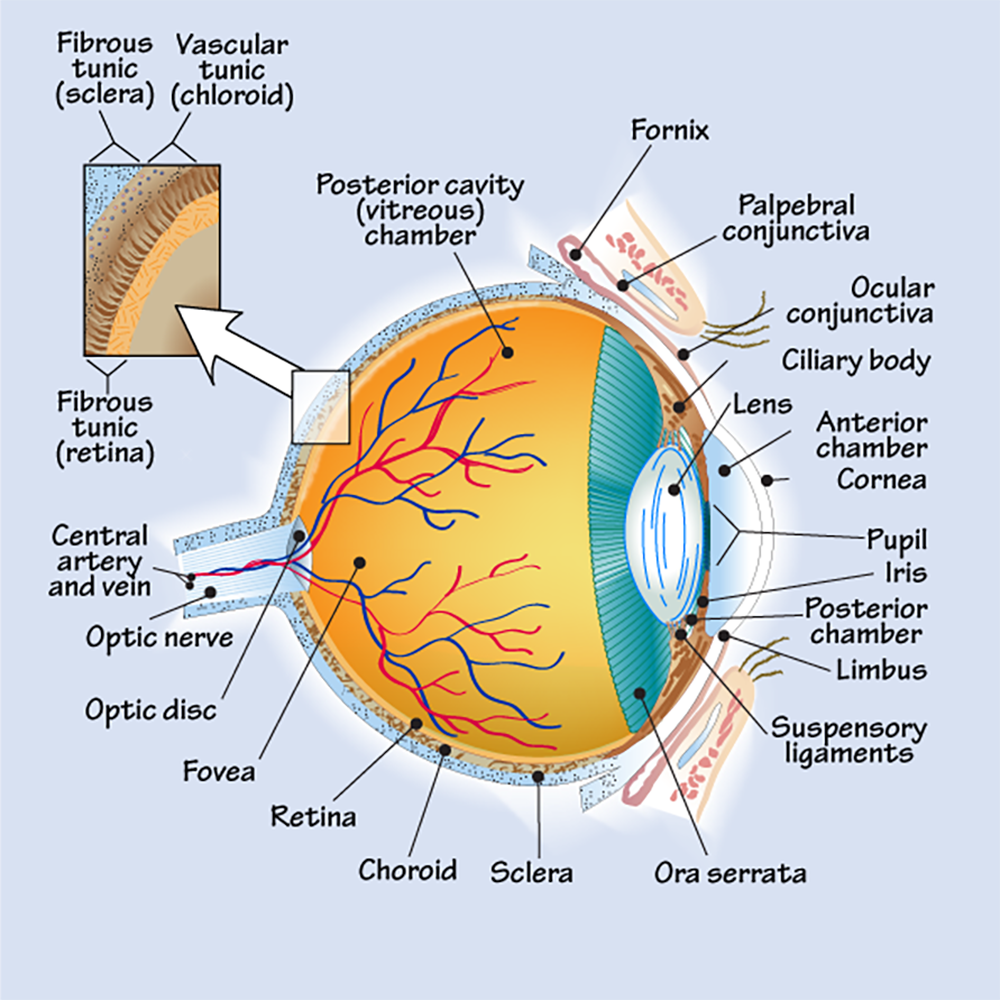
The Retina: Converting Light to Neural Signals
The retina is the light-sensitive layer at the back of the eye, crucial for vision. How does the retina function in the visual process?
- Photoreception: The retina contains photoreceptor cells that convert light into electrical signals.
- Signal processing: It performs initial processing of visual information before sending it to the brain.
- Vascularization: Unlike the cornea and lens, the retina is highly vascularized to support its high metabolic demands.
The retina contains two main types of photoreceptor cells: rods and cones. How do these cells differ in function?
Rod Cells: Masters of Low-Light Vision
Rod cells are specialized for vision in low light conditions. What are their key characteristics?
- Quantity: There are approximately 125 million rod cells in each human retina.
- Sensitivity: Rods are extremely sensitive and can detect even a single photon of light.
- Distribution: They are more concentrated in the peripheral retina, contributing to peripheral vision.
- Scotopic vision: Rods are responsible for night vision and vision in dim light.
Why can’t we see color in very low light? Rod cells do not provide color vision, which is why we see in shades of gray in very dim light conditions.
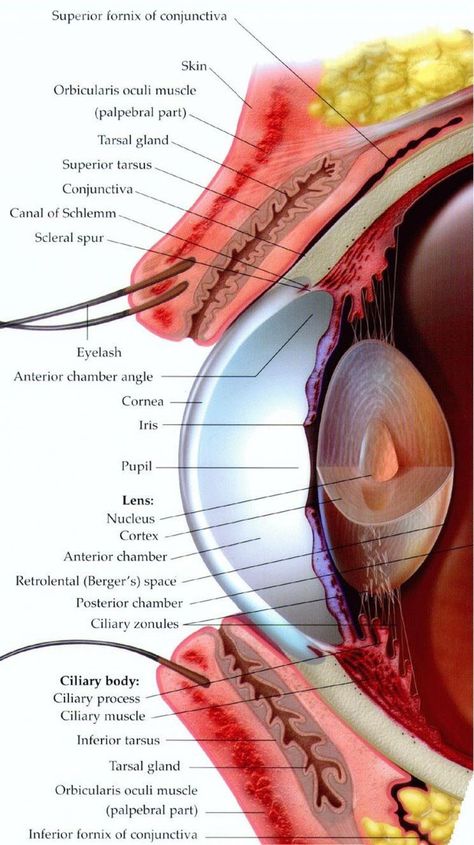
Cone Cells: Color Vision Specialists
Cone cells are responsible for color vision and high acuity vision in bright light. What makes cone cells unique?
- Types: There are three types of cone cells, each sensitive to different wavelengths of light (red, green, and blue).
- Quantity: There are approximately 6-7 million cone cells in each human retina.
- Distribution: Cones are concentrated in the central retina, especially in the fovea, providing high visual acuity.
- Color perception: The combination of signals from the three types of cones allows us to perceive millions of colors.
How many colors can the human eye distinguish? Thanks to the intricate interplay of cone cells, the average human can distinguish about 1 million different colors.
Optic Nerves: The Visual Information Highway
The optic nerve is a crucial component in the visual system, transmitting visual information from the retina to the brain. What are the key features of the optic nerve?
- Structure: It consists of approximately one million nerve fibers.
- Origin: The optic nerve originates from the retina and is considered part of the central nervous system.
- Function: It carries visual information in the form of electrical impulses from the retina to the brain’s visual cortex.
- Blind spot: The point where the optic nerve exits the eye creates a natural blind spot in our visual field.
How fast does visual information travel along the optic nerve? Visual signals travel along the optic nerve at speeds of up to 250 miles per hour, allowing for rapid processing of visual information.

From Eye to Brain: The Visual Pathway
The journey of visual information from the eye to the brain involves several steps:
- Light enters the eye and is focused on the retina.
- Photoreceptors in the retina convert light into electrical signals.
- These signals are processed by various cells in the retina.
- The processed signals travel along the optic nerve.
- The optic nerves from both eyes partially cross at the optic chiasm.
- Visual information continues along the optic tract to the lateral geniculate nucleus in the thalamus.
- Finally, signals reach the primary visual cortex in the occipital lobe of the brain for further processing and interpretation.
This complex pathway allows for depth perception and the integration of visual information from both eyes, resulting in our rich visual experience of the world.
The Eye’s Protective Mechanisms
The eye has several protective mechanisms to safeguard its delicate structures. What are these protective features?
- Eyelids: Provide physical protection and help distribute tears across the eye’s surface.
- Eyelashes: Prevent small particles from entering the eye.
- Tear film: Lubricates the eye and contains antibacterial compounds.
- Bony orbit: The eye socket protects the eye from physical trauma.
- Conjunctiva: A thin membrane that covers the sclera and inner eyelids, providing a barrier against pathogens.
How often do we blink? The average person blinks about 15-20 times per minute, helping to keep the eye’s surface clean and moist.
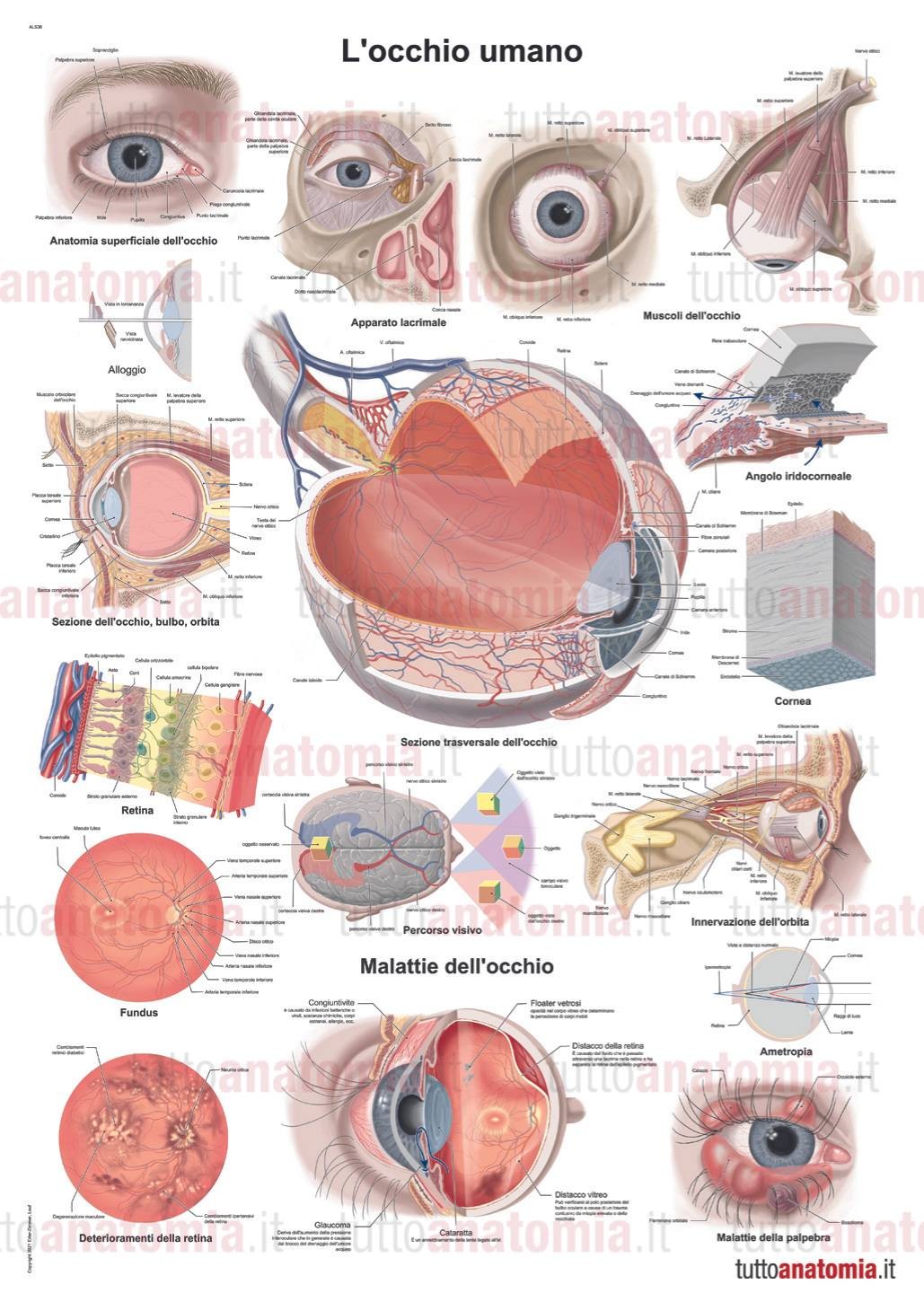
The Importance of Tears
Tears play a crucial role in maintaining eye health. What are the functions of tears?
- Lubrication: Tears keep the eye’s surface smooth and comfortable.
- Protection: They contain enzymes that fight against bacteria and other pathogens.
- Nutrition: Tears provide oxygen and nutrients to the cornea.
- Cleansing: They wash away debris and foreign particles from the eye’s surface.
- Optical function: The tear film helps smooth out minor irregularities on the cornea’s surface, improving visual clarity.
What are the components of tears? Tears are composed of three layers: an outer lipid layer that prevents evaporation, a middle aqueous layer that provides moisture and nutrients, and an inner mucin layer that helps the tear film adhere to the eye’s surface.
Anatomy and Physiology of Human Eye
The eyes are an important part of the human body. It is an essential sense organ of humans. There are five major sense organs are present in the human body. They are Eye, Ear, Nose, Tongue & Skin. The eyes provide a sense of vision. Without vision, no animal can have proper navigation. It is the most useful part of the human body. Human eyes have the feature to look around without moving the neck. As eyes have the power to move their lens. Eyes & Optic Nerves both together work & develops an image of the things which we are seeing. The light comes from the outside & it develops the picture of that object in the eyes. Hence, we can see the image of the object.
Anatomy Of Eye
Eyes are round in shape. But the Eye Leaves cover most of the structure of the eye. Hence, we can see the eye as in a convex structure. But the Eye Leaves are not part of the eye. There are some components in the eye. Those structures together build the anatomy of the Eye. Also, along with the components, there is the secondary structure which helps the eye to smoothly look around.
Also, along with the components, there is the secondary structure which helps the eye to smoothly look around.
Primary Components Of Eye
- Cornea: It is the circular structure present in front of the eyes. We can’t able to see the cornea directly from the outside. As it is circular, we can’t able to identify its position normally. It is just situated at the front of the eye. It is completely transparent. There are no blood vessels present at all in this area. It is a highly sensitive region.
- Sclera: This is the whitest region found in the eye. It covers most of the eye portion which we can look at from the outside.
Aqueous Humour: It is the jelly-like structure present between the Cornea & the lens. There is 99% of water in this portion. Nearly 1% is vitamin, protein & other materials may present. As the name suggests “Aqueous” means the water. And it defines the watery nature of this area. - Iris: It is made with a fiber-like structure.
 It is the circular region present in the middle of the eye. There are some pigments present. According to the inheritance, these pigments are inherited from the parents of any individual. These pigments may be Black, Blue, Brown, etc. as per the heredity. That is why Iris may differ from individuals as per the availability of the pigments.
It is the circular region present in the middle of the eye. There are some pigments present. According to the inheritance, these pigments are inherited from the parents of any individual. These pigments may be Black, Blue, Brown, etc. as per the heredity. That is why Iris may differ from individuals as per the availability of the pigments. - Pupil: This is the circular hollow position present in the center of the Iris.
- Lens: It is olive shape structure present behind the Pupil. It is enclosed in a transparent capsule. There are no blood vessels in this area. This is the main component of the eye.
- Ciliary Muscles: These are the muscles that hold the lens at its position.
- Vitreous Humour: This is another jelly-like structure. It is present inside of the eyeball. It is completely transparent. But it is not soft like jelly. The term “Vitreous” means Glass like structure. But it is not hard as glass.
 But it is transparent like glass.
But it is transparent like glass. - Retina: This is another main component of the eyes. Inside the wall of the eyes, the retina is present all over the wall. This is the receipting component of the eye. But the Retina consists of two different kinds of cells. They are Rod Cells & Cone Cells. Around 130 million cells are present here. Also, only this part has the blood vessels. Also, this part is connected with the nerve.
- Cone Cells: These cells work as light-sensing cells. There are nearly 5 million Cone Cells present in the eye. There are three types of cone cells. These divisions are made based on the color they can accept. There are Red Light Sensing Cone Cell, Green Light Sensing Cone Cell & Blue Light Sensing Cone Cell. Among them, Red light-sensing cells are present most of the number & Blue light-sensing cells are present least in number. All other colors can be accepted by the combination of those cells.
- Rod Cells: These are also the light-sensing cells present in Retina.
 There are 125 million Rod Cells present in Retina. These cells can only able to accept low bright light. They can’t able to accept high-intensity lights.
There are 125 million Rod Cells present in Retina. These cells can only able to accept low bright light. They can’t able to accept high-intensity lights.
Secondary Components of Eye
- Optic Nerves: This is the main component of the secondary eye components. This is very important for visualizing anything. Optic nerves merged with the Retina in the eyes. Nearly one million nerve fibers merged with the Retina. Optic Nerves are part of the Central Nervous System (CNS). They carry the messages from the eye to the brain.
- Layers of Eye: There are mainly three layers present in the eye. The different components of the eye merged & define such layers.
- Fibrous Tunic: It is the outer layer of the eye. It is made with tissues. And it covered the outer layer of the eyes. The outer layer of the eye is also made of Sclera & Cornea of the eye.
- Vascular Tunic: It is the middle layer of the eye.
 Though it is not surrounded the eye. But it divides the eye into Interior & Posterior portions. It is also made with tissues & fibers. The Ciliary Body & Iris are two components that developed the Vascular Tunic.
Though it is not surrounded the eye. But it divides the eye into Interior & Posterior portions. It is also made with tissues & fibers. The Ciliary Body & Iris are two components that developed the Vascular Tunic. - Inner Layer: The inner layer of the eye means the Retina of the eye. There are no tissues present in this area.
Functions Of Eye Components
- Cornea: The cornea helps to bend the light rays. As it is convex in shape, it will bend the outer light source & make convergent beams of light. It helps to pass through the Pupil of the eyes.
- Sclera: It helps to provide the shape to the eyeball. It also helps to protect the eyeballs from any external threats. Also, it has the muscle Conjunctiva, which helps to move the eyeball up & down.
- Aqueous Humour: It helps to maintain the shape of the Cornea. As Cornea is convex, it provides support to the Cornea.
 So, the Cornea will never get misshaped. Also, it helps to reduce the friction while moving the Lens of the eye.
So, the Cornea will never get misshaped. Also, it helps to reduce the friction while moving the Lens of the eye. - Iris: The light beams enter via Cornea. But the complete light beams are not necessary to get inside the eye. Iris absorbs the extra light beams & reflects them. Depending upon the pigments available in the Iris, we can able to see some colored Iris for individual humans. Also, Iris helps to maintain the size of the Pupil. Depending upon the environment the Pupil size gets changed.
- Pupil: It has only a single task to enter the convergent light beams inside of the eyeball. With the help of Iris, Pupil can change its size. Like in darkness, when there is a need to get more light beams inside of the eyeball, Iris helps to get stretched the Pupil. So by the Pupil, more lights enter the eyeball. In more bright light, Iris contract the Pupil. So that minimum light beams can enter the eyeball. Otherwise, more bright light can harm the inside of the eyeball.
 It can able to damage the cells also.
It can able to damage the cells also. - Lens: This helps to make a clear picture of the Retina. The lens works the same as the camera lens. As it is convex it can make convergent light beams. It helps to focus all the convergent light beams to a particular point of the Retina. So a clear picture can be available at Retina.
- Ciliary Muscles: These muscles hold the lens in its place. Also, depending upon the light beams can change the structure of the lens. Like if the incoming light beams are convergent, it will elongate the lens. So that, Lens can make a convergent light beam easily. If the incoming lights are divergent, so the ciliary muscles will compress the Lens. So it can easily focus the convergent light to Retina.
- Vitreous Humor: It is the fluid-like structure present on the inside of the eyeball. It helps to support the shape of the eyeball from the inside. Without it, the shape of the eyes makes gets misshaped due to injury.

- Retina: This helps to collect the light beams from the outside. Then, it will make the picture of the image from where the light is coming. Depending upon the environment the light receipting cells act. After making the image of the object, it provides the details to the Optic Nerve.
- Layers of the Eyes: It helps to protect the eyeball from any injuries. Also, it helps to provide the shape of the eyeball.
- Optic Nerves: These nerves collect information from the retina. Then it decodes the information to the message or commands. Then these messages will transfer to the optic lobe of the brain. There the messages are being interpreted by the brain & the picture of the object can be visualized by the human.
Mechanism Of Eye
The light beams from any of the outer objects first land on the Cornea. The makes them convergent light beams & try to focus them on the Pupil. Then via Aqueous Humour, the light beams come to the Pupil. Some radio of the light beams gets absorbed by the Iris. The remaining light beam directly enters the eyeball. Now, depending upon the nature of the light beam, the Lens tries to make a convergent light beam & focus it on a certain point at Retina. After being convergent by the Lens, the light beam travels via Vitreous Humour & then lands on the special region of the Retina. This is a special region as this region can able to make a clear picture. The other region of Retina can also be able to make the picture, but they are not so clear. But the picture developed in the Retina is the reverse of the actual object. Then this image is converted to the message & received by the Optic Nerves. The Optic Nerves then took the messages & transfer them to the Optic Lobe of the Brain. Their brain reads the message & develops the reverse of the accepted image. Hence, it will develop the actual image of the object. The working of the eye is as same as the camera. Here, Iris works as aperture & Retina works as a film of the camera.
Some radio of the light beams gets absorbed by the Iris. The remaining light beam directly enters the eyeball. Now, depending upon the nature of the light beam, the Lens tries to make a convergent light beam & focus it on a certain point at Retina. After being convergent by the Lens, the light beam travels via Vitreous Humour & then lands on the special region of the Retina. This is a special region as this region can able to make a clear picture. The other region of Retina can also be able to make the picture, but they are not so clear. But the picture developed in the Retina is the reverse of the actual object. Then this image is converted to the message & received by the Optic Nerves. The Optic Nerves then took the messages & transfer them to the Optic Lobe of the Brain. Their brain reads the message & develops the reverse of the accepted image. Hence, it will develop the actual image of the object. The working of the eye is as same as the camera. Here, Iris works as aperture & Retina works as a film of the camera.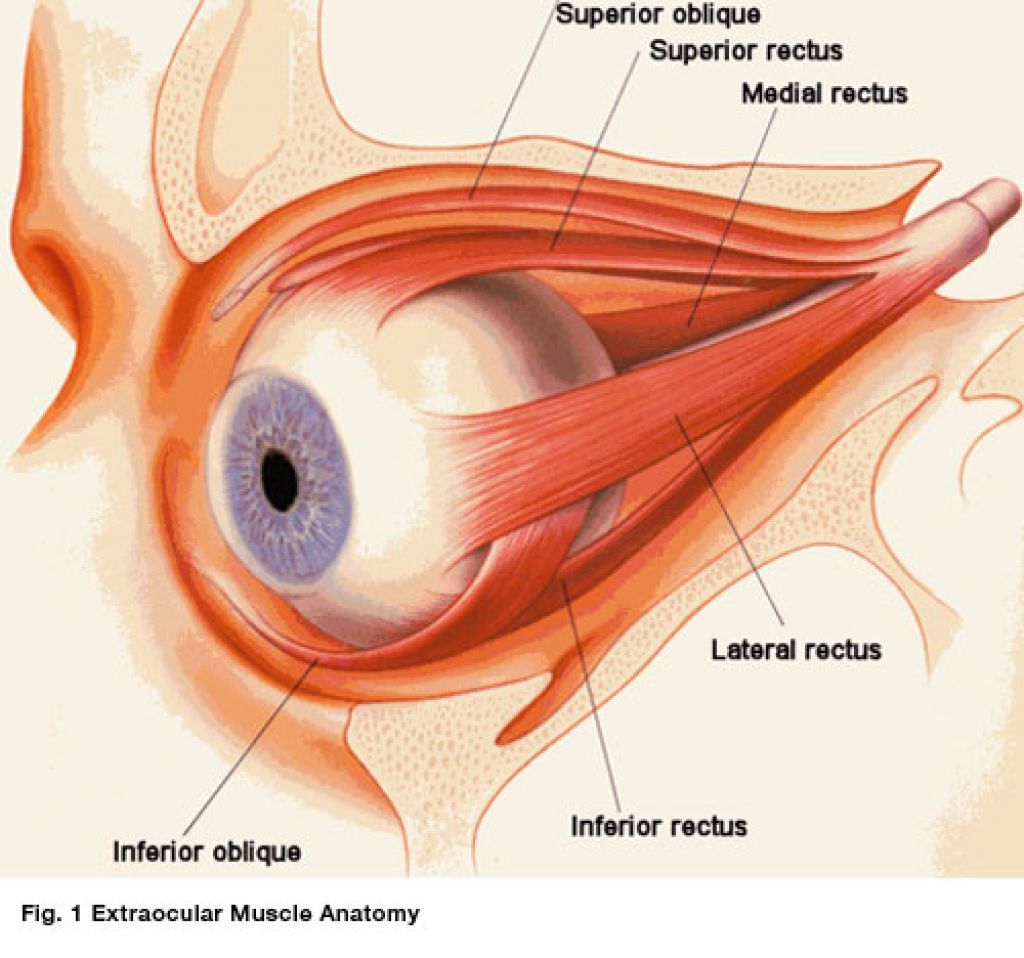
What is Eye Movement?
Inside our eyes, there is only one type of muscle is present. They are the ciliary muscles. Along with that, there are some muscles present outside of the Sclera. These muscles help to rotate the eye. There are six muscles present. They are plays the main role to rotate the eyeball. Eyes have the Optic Nerve. By that Eyes sends the signal to the brain. By which we can visualize anything. The same comes Cranial Nerves are there. These nerves connect the brain with the Eye in a different form. Through these nerves, Barin sends signals to the muscles of the Eyeball. Hence, they can rotate themselves to a certain degree of position.
According to scientists, there are mainly four types of Eye Movements can be found. Based upon the action & muscles interaction these names are generated.
- Saccades: This movement is used to see a rapid change in the position of an object. This movement involves when we don’t have the option to move the head & neck.
 At that point of time of gazing at a certain object which moves very fast, this Eye Movement helps us to look at that.
At that point of time of gazing at a certain object which moves very fast, this Eye Movement helps us to look at that. - Vergence: This is a special kind of Eye movement. This type of movement can visualize when we need to focus on a certain object. It helps to make a clear image in the Retina. The eye moves in such a way that light beams from that object land on the focus area.
- Smooth Pursuit: This is a very soft kind of movement in the Eye. This is a very smooth movement rather than other movements in the Eye. When we have to continuously gaze at an object which is moving in a small amount, then this movement helps us. In this movement, Eyeball rotates in a very small amount. Hence, there is no extra work have to be done by the Eye muscles.
- Vestibulocular: This is another type of Eye movement. In some fields, where the heads move drastically. But the eye needs to focus on any object to see it. Then this type of movement can be observed.
 This type of movement can observe in a crowded place. These individuals need to observe certain interesting things. But due to the huge crowd, they can’t properly see them. As a result, they move their head at two different sides of their body. With that, the Eyes need to move to focus on the object.
This type of movement can observe in a crowded place. These individuals need to observe certain interesting things. But due to the huge crowd, they can’t properly see them. As a result, they move their head at two different sides of their body. With that, the Eyes need to move to focus on the object.
Near Response of Eye
This type of response in the Eye can observe when individuals sit in a car or any moving things. Here, at some point in time, an object was situated at a distance. But with time it comes closer to the individuals. Then Eye needs to refocus on it to get a clear image of it. For that purpose, the Eye needs to change its Lens structure. This is called a Near Response.
When a light beam is coming from a distance, it creates a divergent light beam. To focus divergent light beams at a certain focal point, Eye makes some changes to the Lens. The Ciliary muscles contrasted the Lens. Hence, the width of the Lens gets increased. So it can easily make convergent light beams with such a Lens structure. But when the object comes nearer to the individuals, the incoming divergent lights become nearly parallel light beams. So, to make the focus of such parallel light beams Ciliary muscles elongated the Lens structure. Hence, it can easily get the image of the object.
But when the object comes nearer to the individuals, the incoming divergent lights become nearly parallel light beams. So, to make the focus of such parallel light beams Ciliary muscles elongated the Lens structure. Hence, it can easily get the image of the object.
Along with that when the object is situated far from the individual, the Iris also gets contrasted & helps the Pupil to get extended. It helps to collect more divergent light beams from the object. And when the object comes nearer to the individual, the Pupil gets contrasted to stop more incoming Parallel light beams. These actions of the Eye are known as the Near Response of the Eye.
Importance Of Eye
The eye is an important sensing organ in our body. It helps to visualize anything which we are seeing. Also, along with that, it helps to navigate us in any situation. Without looking at anything it is very difficult to know where is anything situated. It is the main part of the body that helps to identify anything. Some lower-class animals don’t have a powerful eye. But they pose a sensing organ that helps to navigate them. The importance of the eye doesn’t need to clarify. Without it, we can never spend a single day. It is not only a sensing organ & also a navigating organ. The individuals who don’t have a working eye or have any difficulty in vision know the importance of the eye. In every aspect of our daily life, we use our eyes. From typing a message to playing a game, the eye is being used in every field. It helps us to live our life easier. It helps to visualize the world.
Some lower-class animals don’t have a powerful eye. But they pose a sensing organ that helps to navigate them. The importance of the eye doesn’t need to clarify. Without it, we can never spend a single day. It is not only a sensing organ & also a navigating organ. The individuals who don’t have a working eye or have any difficulty in vision know the importance of the eye. In every aspect of our daily life, we use our eyes. From typing a message to playing a game, the eye is being used in every field. It helps us to live our life easier. It helps to visualize the world.
Eye Irritation
Eye irritation is a term that defines some common problems related to the Eyes. In such cases, individuals can feel itches, pain, vision problem, etc. These cases are very common in humans. We can note some problems like:
- Dryness of Eye: It is a problem in the eye. Our eye has lacrimal glands. These glands wet our eyes. Due to long use of mobiles, laptops for a while.
 These cases can develop. Long use of electronic devices leads to dry eyes. As the lacrimal glands can’t work properly in such cases.
These cases can develop. Long use of electronic devices leads to dry eyes. As the lacrimal glands can’t work properly in such cases. - Itches of Eye: Some common problems with the eye are related to foreign elements. Some pollen or chemical can lead to itches in the eye.
- Allergic Reaction: Human Eyes are very sensitive with the allergy. Due to some allergies to the eye, the eye can get red. It can lead to severe itches in the eye. Also, if the human body is affected by allergies, then the eye can also be a symptom in such cases.
Disorders With Eye
There are several disorders are present with the eye. Some of them are very common in humans. But some of them are very rare in case. Some of them don’t completely make a human blind. But some of them can make visual impairment.
- Common Disorders with Eye
- Myopia: It is a disorder when the individuals can able to see an object which is situated near to them.
 But they can’t able to see the objects which are far from them. Due to a problem with the Eye Lens this type of problem may arise. In such cases, individuals need a spectacle to remove the problem.
But they can’t able to see the objects which are far from them. Due to a problem with the Eye Lens this type of problem may arise. In such cases, individuals need a spectacle to remove the problem. - Hyperopia: It is the objects which are situated far from individuals can able to see clearly. But those objects which are situated nearer to them are not been seen. In such cases, individuals need to get a spectacle to remove the solution.
- Cataract: It is a very common disorder in older aged people. A thin layer of protein developed on the Lens of the Eye. Thus it makes a cloudy-like structure in front of the eye. In these cases, clear visions are distracted. In this case, the Lens of the eyes is being removed. And in place of that, an artificial lens is provided to the individuals.
- Myopia: It is a disorder when the individuals can able to see an object which is situated near to them.
- Rare Disorders with Eye
- Coloboma: It is a disease in the eye where the tissues which protect the eye from injuries are missing.
 It is a very rare disease. In this disease, the chance to get injuries to the eye is much higher than the normal cases.
It is a very rare disease. In this disease, the chance to get injuries to the eye is much higher than the normal cases. - Anophthalmia and Microphthalmia: These are inborn diseases. In the case of Anophthalmia, a child takes birth without the eyes. The child doesn’t have an eye. In the case of Microphthalmia, the child has the eyes. But they are not working in nature.
- Usher Syndrome: It is a disease where a child has both hearing & vision impairment. As well as in this disease the child may have a problem with balance. This disease occurs due to genetic impairment in a child. This is a very rare disease. Nearly, 4-17 children get affected per 100000.
- Coloboma: It is a disease in the eye where the tissues which protect the eye from injuries are missing.
FAQs on Human Eye
Question 1: What is Blind Spot?
Answer:
The blind spot is the region in the eye. It is the region where the Retina gets connected with the Optic Nerves. In this region, light doesn’t get to land.
The light which will land in this area will not be received by the Optic Nerves. Thus this area does not develop any picture at Retina. That is why it is called Blind Spot.
Question 2: What is Yellow Spot?
Answer:
Yellow Spot is often known as Macula. It is the region in the eye. It is on the opposite side of the Pupil. Rarely light beam gets land in this area. This area has a high concentration of Cone cells. If light gets landed in this area a yellowish color image will appear.
Question 3: What is Optic Disc?
Answer:
The Optic Disc is the region where the Optic Nerve gets connected to the Retina. It is the starting point of the Optic Nerve. Sometimes this area can be visualized from the outside of the eyes. It is often called a Blind Spot.
Question 4: What is Fovea?
Answer:
It is the region in the eye where the light gets focused by the Lens.
In this region, a clear image of the object is developed. This is the region where the clearest, correctly developed picture can be available. From this region, the Optic Nerves take the messages.
Question 5: According to Scientists, why are the cone cell intensity high in the human eye?
Answer:
Human Eyes have nearly 125 million Cone Cell. These cells are only used to receive dim light. And Rod Cells are nearly 5 million in number. Scientists believe that in the ancient era when humans only lived in the caves, they mostly use the Cone Cell for vision. As there was not any bright light available at those time. According to the rule of evolution, the Cone Cells developed most. And in this way, Cone Cells are large in numbers than Rod Cells.
The eye and visual nervous system: anatomy, physiology and toxicology.
- Journal List
- Environ Health Perspect
- v.
 44; 1982 Apr
44; 1982 Apr - PMC1568971
As a library, NLM provides access to scientific literature. Inclusion in an NLM database does not imply endorsement of, or agreement with,
the contents by NLM or the National Institutes of Health.
Learn more about our disclaimer.
Environ Health Perspect. 1982 Apr; 44: 1–8.
doi: 10.1289/ehp.82441
PMCID: PMC1568971
PMID: 7084144
Copyright and License information Disclaimer
Abstract
The eyes are at risk to environmental injury by direct exposure to airborne pollutants, to splash injury from chemicals and to exposure via the circulatory system to numerous drugs and bloodborne toxins. In addition, drugs or toxins can destroy vision by damaging the visual nervous system. This review describes the anatomy and physiology of the eye and visual nervous system and includes a discussion of some of the more common toxins affecting vision in man.
Full text
Full text is available as a scanned copy of the original print version. Get a printable copy (PDF file) of the complete article (2.0M), or click on a page image below to browse page by page. Links to PubMed are also available for Selected References.
1
2
3
4
5
6
7
8
Images in this article
Click on the image to see a larger version.
Selected References
These references are in PubMed. This may not be the complete list of references from this article.
- HOBBS HE, CALNAN CD. The ocular complications of chloroquine therapy. Lancet. 1958 Jun 7;1(7032):1207–1209. [PubMed] [Google Scholar]
- Nylander U. Ocular damage in chloroquine therapy. Acta Ophthalmol (Copenh) 1966;44(3):335–348. [PubMed] [Google Scholar]
- Krill AE, Potts AM, Johanson CE. Chloroquine retinopathy. Investigation of discrepancy between dark adaptation and electroretinographic findings in advanced stages.
 Am J Ophthalmol. 1971 Feb;71(2):530–543. [PubMed] [Google Scholar]
Am J Ophthalmol. 1971 Feb;71(2):530–543. [PubMed] [Google Scholar] - Percival SP, Behrman J. Ophthalmological safety of chloroquine. Br J Ophthalmol. 1969 Feb;53(2):101–109. [PMC free article] [PubMed] [Google Scholar]
- Hagopian V, Stratton DB, Busiek RD. Five cases of pigmentary retinopathy associated with thioridazine administration. Am J Psychiatry. 1966 Jul;123(1):97–100. [PubMed] [Google Scholar]
- COLE DF. LOCATION OF OUABAIN-SENSITIVE ADENOSINE TRIPHOSPHATASE IN CILIARY EPITHELIUM. Exp Eye Res. 1964 Mar;3:72–75. [PubMed] [Google Scholar]
- KINSEY VE. The chemical composition and the osmotic pressure of the aqueous humor and plasma of the rabbit. J Gen Physiol. 1951 Jan;34(3):389–402. [PMC free article] [PubMed] [Google Scholar]
- ARMALY MF. EFFECT OF CORTICOSTEROIDS ON INTRAOCULAR PRESSURE AND FLUID DYNAMICS. I. THE EFFECT OF DEXAMETHASONE IN THE NORMAL EYE. Arch Ophthalmol. 1963 Oct;70:482–491. [PubMed] [Google Scholar]
- BECKER B, HAHN KA. TOPICAL CORTICOSTEROIDS AND HEREDITY IN PRIMARY OPEN-ANGLE GLAUCOMA.
 Am J Ophthalmol. 1964 Apr;57:543–551. [PubMed] [Google Scholar]
Am J Ophthalmol. 1964 Apr;57:543–551. [PubMed] [Google Scholar] - Chylack LT, Jr, Kinoshita JH. A biochemical evaluation of a cataract induced in a high-glucose medium. Invest Ophthalmol. 1969 Aug;8(4):401–412. [PubMed] [Google Scholar]
Articles from Environmental Health Perspectives are provided here courtesy of National Institute of Environmental Health Sciences
The structure of the human eye: anatomy, description
Structure and function of the human eye
Our eyes are a complex apparatus that allows a person to receive information and see the world in all its glory. The eyes have a very complex structure – they combine various tissue structures and vascular systems.
Understanding what the eye consists of, how its components work and what functions they perform, helps to carefully and competently treat one’s own vision, recognize “signals” of violations and, accordingly, make decisions to eliminate them.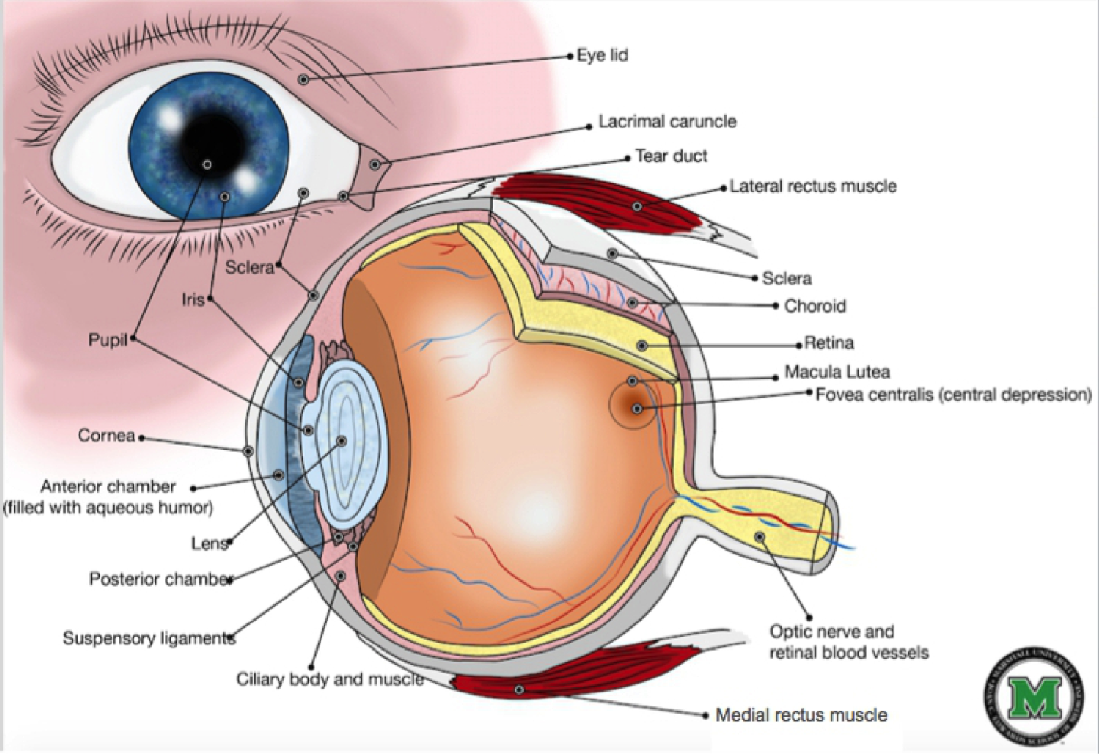
Eyeball
Due to its spherical or spherical shape, the human eye has received the name “eyeball”. It is located in the eye socket – a special bone structure of the skull that protects the eyeball from damage. The anterior surface of the eyeball is protected by the eyelids.
The six external muscles provide movement of the eyeball and create binocular vision – that is, seeing with two eyes, which creates a three-dimensional image (stereoscopic vision).
Through the lacrimal ducts, the outflow of tear fluid occurs. The lacrimal glands produce tears that moisturize the surface of the eyeball and create a protective film on its surface.
Sheaths of the eye
There are several layers of the eye.
Conjunctiva is the outer transparent membrane that covers the surface of the eye and the inside of the eyelids. The conjunctiva aids in the necessary gliding during eyeball movement.
Fibrous membrane is a gas sheath that consists of the sclera, limbus, and cornea.
Sclera is a white shell that performs protective and supporting functions. This is the densest part of the eyeball.
Limbo is the transitional membrane of the eye between the sclera and the cornea. The limbus contains stem cells that regenerate the outer layers of the cornea.
Cornea is the transparent part of the fibrous membrane. It is abundantly supplied with nerves, therefore it is characterized by high sensitivity. The transparency of the cornea allows light rays to penetrate into the eye.
Choroid — part of the eye that provides blood supply to the eye and trophism (nutrition) of its cells. The choroid is composed of:
- Choroid – a structure that is in close contact with the retina and sclera, performing the functions of nutrition and shock absorption
- Ciliary body – (providing vision at different distances) and producing (producing) aqueous humor (intraocular fluid)
- The iris, which determines the color of our eyes, and the pupil, the opening for light rays to enter
- The retina is the inner lining of the eye.
 The retina is a very thin, less than one-third of a millimeter (300 microns) thick, light-sensitive tissue. It provides the main functions of the organs of vision – central and peripheral (lateral) vision. This is where the optic nerve fibers begin, through which impulses pass to the brain, providing our visual perception.
The retina is a very thin, less than one-third of a millimeter (300 microns) thick, light-sensitive tissue. It provides the main functions of the organs of vision – central and peripheral (lateral) vision. This is where the optic nerve fibers begin, through which impulses pass to the brain, providing our visual perception.
The thin sensitive part of the retina is responsible for the central vision of a person – macula .
Eye chambers
The chambers of the eye are closed and interconnected spaces. They contain intraocular fluid that nourishes the cornea and lens. There are two chambers in the eyeball – anterior and posterior.
Anterior is located between the cornea and the iris. And between the peripheral part of the cornea and the iris, the angle of the anterior chamber is isolated. In this place, the outflow of intraocular fluid is carried out.
The posterior chamber is located between the iris and the posterior surface of the ciliary body.
Behind the iris is lens . It has the shape of a biconvex lens and is attached to the ciliary (ciliary) body with the help of a large number of thin ligaments.
Behind the lens, the cavity of the eyeball is filled with vitreous body , which is necessary to maintain the tension of the cell membranes of the eye (turgor).
Optical system of the eye
The optical system of the eye is our vision. The optical system allows a person to visually perceive all kinds of objects of the external world. The clarity of vision is determined by the state of the most important structures of the optical system – the cornea, lens and vitreous body.
The cornea refracts light rays, which then pass through the pupil and form an image. The pupil is often compared to the aperture of a camera – it is he who is responsible for the “clarity” of the resulting picture.
Through lens , light rays enter the retina, the light-perceiving structure of the eye.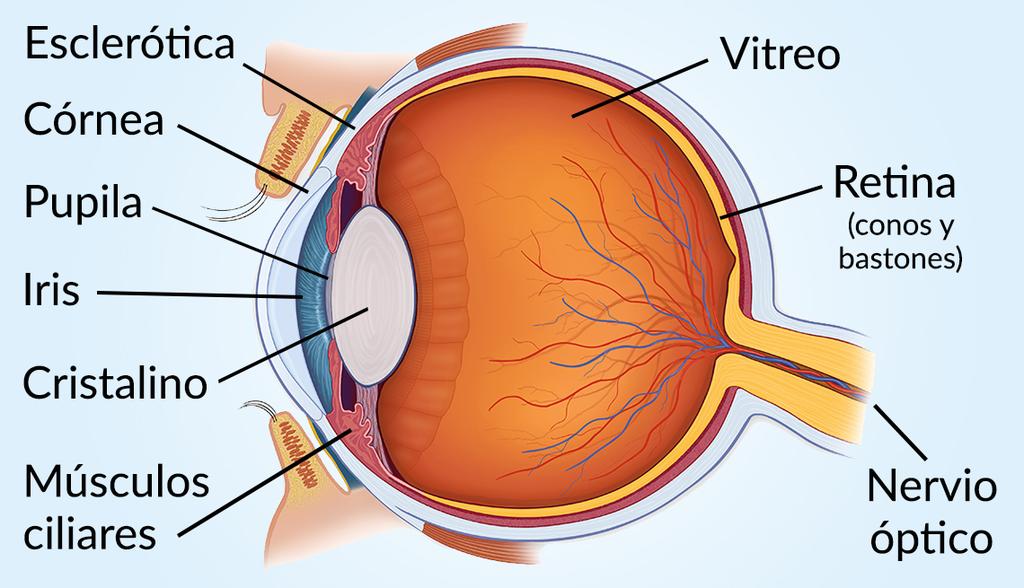
The vitreous body and the degree of transparency of the intraocular fluid in the eye chambers affect the quality of our visual acuity. So, sometimes blood clots or other floating opacities form in aqueous humor, which can reduce vision.
After hitting the retina, light rays transmit special impulses to the brain along the fibers of the optic nerve. The brain analyzes the information and produces the final real image.
Our eye – like a separate organism – literally every second performs complex work, the clarity and success of which depends on the healthy state of each structure of the visual apparatus.
Anatomy of the human eye, functionality of vision
The eyes are a paired organ, the correct operation of which provides 90% of information about the world around us. This analyzer has a fairly complex anatomy . Its important feature is binocular vision, which allows you to perceive the world around you with both eyes. The visual apparatus is highly sensitive to various harmful factors and needs especially careful care.
The visual apparatus is highly sensitive to various harmful factors and needs especially careful care.
The organs of vision are spherical in shape, which is why they are called “eyeballs”. They are located in the recesses of the skull (eye sockets). The anterior surface of each eye is protected by the upper and lower eyelids.
The main elements of the eyeball:
- cornea;
- iris;
- pupil;
- lens;
- retina;
- vitreous body;
- sclera.
Eye movement is provided by 6 muscles (4 straight and 2 oblique). The transmission of optical impulses to the brain is carried out by the optic nerve, which is a plexus of the finest fibers.
Structure and function of the cornea
This elastic shell is similar in shape to a convex-concave lens. Cornea protects the front of the eye. It does not contain blood vessels and consists of 5 layers.
In the normal state, the cornea of the eye is transparent, shiny and smooth, has a high degree of sensitivity. Corneal diameter:
Corneal diameter:
- vertical – 11.5 mm;
- horizontally – 12 mm.
The average thickness of the central part is 500 microns, the peripheral part is up to 1 mm.
The cornea transmits light rays through itself, due to which a three-dimensional image is perceived. It is the main refractive medium of the vision organ .
Structure and function of the iris
Iris , or the iris, is located behind the anterior chamber of the eye. It is made up of two muscle groups.
The iris performs the following functions:
- regulates the amount of light entering the internal structures of the eyeball;
- separates the cornea and lens from each other;
- helps to change the size of the pupillary opening;
- is involved in the formation of a clear picture.
The degree of pigmentation of the iris determines the color of the eyes, which is the most diverse. Sometimes pigment cells are distributed unevenly in it, leading to the development of heterochromia.
Sometimes pigment cells are distributed unevenly in it, leading to the development of heterochromia.
Function and structure of the pupil
Pupil is in the center of the iris. It looks like a round black hole that can change its diameter (narrow and expand). This function is provided by two muscles – the sphincter and the dilator.
The mechanism of the pupil has much in common with the aperture of the camera:
- it shrinks in bright light for a clearer image;
- with a lack of light, the reverse process occurs – expansion.
The pupil controls how much light enters the eye. Tapering, it minimizes the ingress of light, protects internal structures from burns. Also, the pupil helps to eliminate the glow around the objects in question.
The structure and function of the lens
Lens occupies the posterior eye chamber. It is shaped like a biconvex lens. Its anterior surface is flatter than the posterior. The thickness of the lens is 4-5 mm, height – about 9mm.
Its anterior surface is flatter than the posterior. The thickness of the lens is 4-5 mm, height – about 9mm.
Normally, this element of the eye is transparent, since it contains a special protein called crystallin. In the organ of vision, it is held by special ligaments that help it change curvature.
The lens refracts light and directs it to the right areas of the eye. The refractive power of a natural lens is 20-22 D. By changing its shape, a person can distinguish between near and far objects.
Structure and function of the retina
The retina, or retina, is a highly sensitive tissue composed of several layers. This is the inner shell of the eye, which is formed by neurons and blood vessels.
The retina contains two types of receptors – rods and cones, so named because of their shape. They allow the eye to see light.
The retina plays a vital role in providing visual perception. It is responsible for central and peripheral vision, the ability to see colors and shades.
Vitreous
Vitreous appears as a clear, colorless gel-like substance. This structure has a spherical shape and occupies up to 2/3 of the eyeball.
Almost 99% of the vitreous body is water. The remainder is represented by collagen, amino acids, mucin, urea, potassium, magnesium and other compounds.
The vitreous body provides adequate nutrition for the retina and the optimal position of the lens, maintains normal intraocular pressure (IOP). Also, this element protects the visual organ from negative effects, weakens the effects of injuries.
What is the sclera and why is it needed
The sclera is the dense, opaque part of the outer shell of the eye. It is formed by collagen fibers, giving it density.
The sclera occupies most of the fibrous membrane of the eyeball. In different parts, its thickness ranges from 0.3 mm to 1 mm.
The main functions of the sclera are support for the internal and external structures of the visual organ, protection from adverse factors, protection of the retina from excessive light.

 It is the circular region present in the middle of the eye. There are some pigments present. According to the inheritance, these pigments are inherited from the parents of any individual. These pigments may be Black, Blue, Brown, etc. as per the heredity. That is why Iris may differ from individuals as per the availability of the pigments.
It is the circular region present in the middle of the eye. There are some pigments present. According to the inheritance, these pigments are inherited from the parents of any individual. These pigments may be Black, Blue, Brown, etc. as per the heredity. That is why Iris may differ from individuals as per the availability of the pigments. But it is transparent like glass.
But it is transparent like glass. There are 125 million Rod Cells present in Retina. These cells can only able to accept low bright light. They can’t able to accept high-intensity lights.
There are 125 million Rod Cells present in Retina. These cells can only able to accept low bright light. They can’t able to accept high-intensity lights. Though it is not surrounded the eye. But it divides the eye into Interior & Posterior portions. It is also made with tissues & fibers. The Ciliary Body & Iris are two components that developed the Vascular Tunic.
Though it is not surrounded the eye. But it divides the eye into Interior & Posterior portions. It is also made with tissues & fibers. The Ciliary Body & Iris are two components that developed the Vascular Tunic. So, the Cornea will never get misshaped. Also, it helps to reduce the friction while moving the Lens of the eye.
So, the Cornea will never get misshaped. Also, it helps to reduce the friction while moving the Lens of the eye. It can able to damage the cells also.
It can able to damage the cells also.
 At that point of time of gazing at a certain object which moves very fast, this Eye Movement helps us to look at that.
At that point of time of gazing at a certain object which moves very fast, this Eye Movement helps us to look at that. This type of movement can observe in a crowded place. These individuals need to observe certain interesting things. But due to the huge crowd, they can’t properly see them. As a result, they move their head at two different sides of their body. With that, the Eyes need to move to focus on the object.
This type of movement can observe in a crowded place. These individuals need to observe certain interesting things. But due to the huge crowd, they can’t properly see them. As a result, they move their head at two different sides of their body. With that, the Eyes need to move to focus on the object. These cases can develop. Long use of electronic devices leads to dry eyes. As the lacrimal glands can’t work properly in such cases.
These cases can develop. Long use of electronic devices leads to dry eyes. As the lacrimal glands can’t work properly in such cases.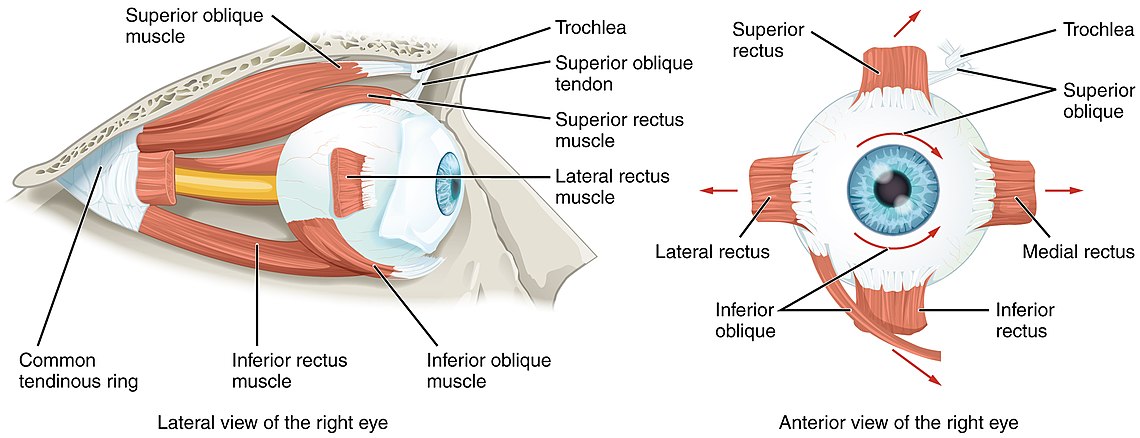 But they can’t able to see the objects which are far from them. Due to a problem with the Eye Lens this type of problem may arise. In such cases, individuals need a spectacle to remove the problem.
But they can’t able to see the objects which are far from them. Due to a problem with the Eye Lens this type of problem may arise. In such cases, individuals need a spectacle to remove the problem. It is a very rare disease. In this disease, the chance to get injuries to the eye is much higher than the normal cases.
It is a very rare disease. In this disease, the chance to get injuries to the eye is much higher than the normal cases. The light which will land in this area will not be received by the Optic Nerves. Thus this area does not develop any picture at Retina. That is why it is called Blind Spot.
The light which will land in this area will not be received by the Optic Nerves. Thus this area does not develop any picture at Retina. That is why it is called Blind Spot.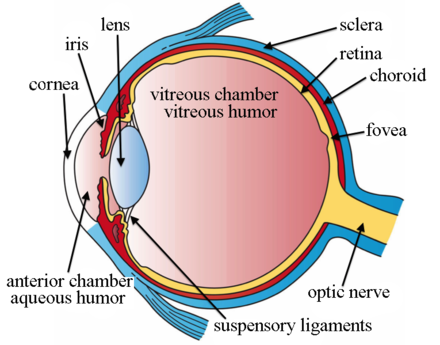 In this region, a clear image of the object is developed. This is the region where the clearest, correctly developed picture can be available. From this region, the Optic Nerves take the messages.
In this region, a clear image of the object is developed. This is the region where the clearest, correctly developed picture can be available. From this region, the Optic Nerves take the messages. 44; 1982 Apr
44; 1982 Apr Am J Ophthalmol. 1971 Feb;71(2):530–543. [PubMed] [Google Scholar]
Am J Ophthalmol. 1971 Feb;71(2):530–543. [PubMed] [Google Scholar] Am J Ophthalmol. 1964 Apr;57:543–551. [PubMed] [Google Scholar]
Am J Ophthalmol. 1964 Apr;57:543–551. [PubMed] [Google Scholar]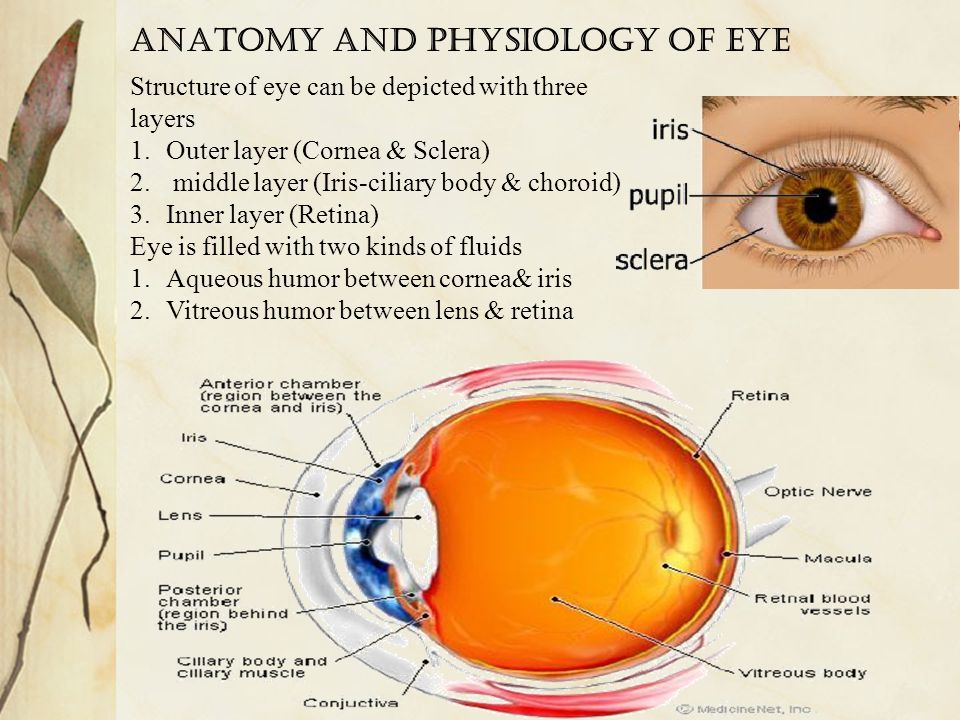 The retina is a very thin, less than one-third of a millimeter (300 microns) thick, light-sensitive tissue. It provides the main functions of the organs of vision – central and peripheral (lateral) vision. This is where the optic nerve fibers begin, through which impulses pass to the brain, providing our visual perception.
The retina is a very thin, less than one-third of a millimeter (300 microns) thick, light-sensitive tissue. It provides the main functions of the organs of vision – central and peripheral (lateral) vision. This is where the optic nerve fibers begin, through which impulses pass to the brain, providing our visual perception.